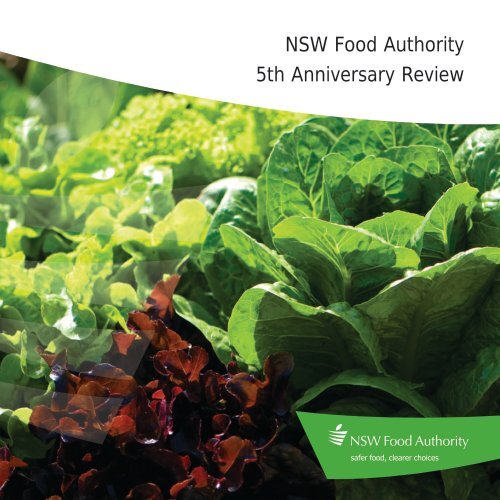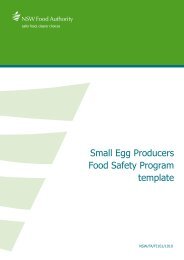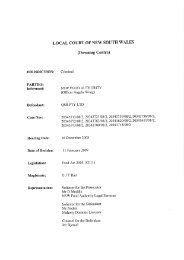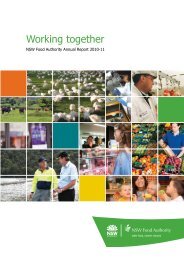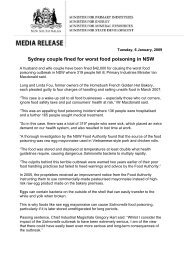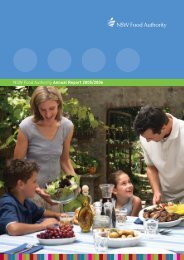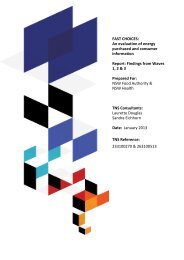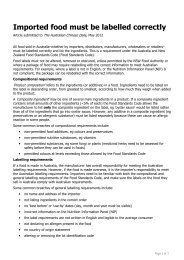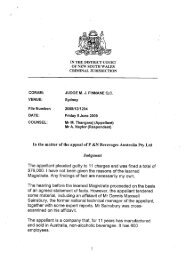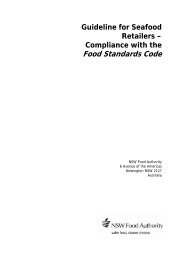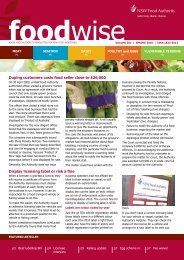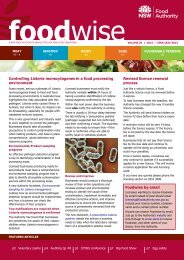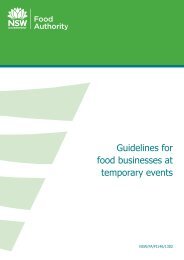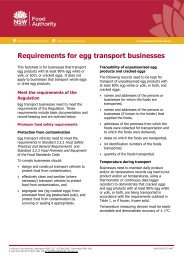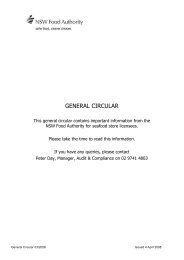NSW Food Authority 5th Anniversary Review
NSW Food Authority 5th Anniversary Review
NSW Food Authority 5th Anniversary Review
Create successful ePaper yourself
Turn your PDF publications into a flip-book with our unique Google optimized e-Paper software.
<strong>NSW</strong> <strong>Food</strong> <strong>Authority</strong><br />
<strong>5th</strong> <strong>Anniversary</strong> <strong>Review</strong>
Message from the CEO<br />
The <strong>NSW</strong> <strong>Food</strong> <strong>Authority</strong> is celebrating its fifth anniversary this year. This is a<br />
tremendous milestone.<br />
Since our inception in April 2004, the <strong>Authority</strong> has led the way in food safety,<br />
working closely with industry and food businesses to identify risks and actively reduce<br />
them. Our success reflects the ongoing commitment by the <strong>Authority</strong> and the State<br />
Government to maintain the high level of food safety standards in New South Wales.<br />
During the past five years we have gone from strength to strength, marked by<br />
achievements which include the consolidation of food safety schemes across key<br />
industries and the development of a comprehensive database tool which manages<br />
information on our interaction with the food industry.<br />
Most notable has been the success of our ‘name and shame’ web portal, introduced in<br />
2008. The first of its type in Australia, it gives consumers access to information about<br />
successful food prosecutions and penalty notices on the <strong>Authority</strong>’s website. Traffic to our<br />
website since the launch of ‘name and shame’ has increased by more than 173%.<br />
The primary<br />
responsibility of the<br />
<strong>NSW</strong> <strong>Food</strong> <strong>Authority</strong><br />
is the protection of<br />
public health.<br />
Our success has only been possible with the support of our staff, our Minister and<br />
our partners – <strong>NSW</strong> Health, the former <strong>NSW</strong> Department of Primary Industries, local<br />
councils, industry and consumer groups.<br />
We are now a partner agency of the newly formed department of Industry & Investment<br />
<strong>NSW</strong>, and in a great position to tackle the challenges of the next five years and beyond.<br />
Alan Coutts<br />
Chief Executive Officer<br />
<strong>NSW</strong> <strong>Food</strong> <strong>Authority</strong><br />
2
Our Minister<br />
The <strong>NSW</strong> <strong>Food</strong> <strong>Authority</strong> plays a vital role in protecting the consumers of this state.<br />
During its first five years, the agency has worked closely with the State Government<br />
and with industry and business to help minimise foodborne illness.<br />
In doing this, the <strong>Authority</strong> has dedicated considerable resources to educating and<br />
informing consumers and stakeholders on food safety issues. The growing interest in<br />
the agency’s website (and ‘name and shame’ web portal) is testimony to this.<br />
Over the years, the <strong>Authority</strong> has amply demonstrated its ability to identify, and<br />
respond quickly to, emerging issues, incidents, foodborne illness emergencies and<br />
outbreaks, ensuring consumers remain protected and reassured.<br />
This is a result of strong leadership and the dedication of a highly skilled team which<br />
includes scientists, food safety officers and regulatory experts.<br />
I congratulate the <strong>Authority</strong> on its five-year milestone and look forward to working<br />
closely with the team as we move into a new decade of food safety regulation.<br />
Hon. Tony Kelly MLC<br />
<strong>NSW</strong> Minister for Primary Industries<br />
3
OUR PURPOSE<br />
Who we are<br />
We are Australia’s first and only through-chain food<br />
regulatory agency, regulating and monitoring food safety<br />
across New South Wales – from primary production<br />
through to point-of-sale.<br />
Background<br />
The <strong>NSW</strong> <strong>Food</strong> <strong>Authority</strong> is a government agency that<br />
works to ensure food sold in the state is safe and<br />
correctly labelled.<br />
We were established on 5 April 2004 through the merger<br />
of Safe<strong>Food</strong> <strong>NSW</strong> with the food regulatory activities of<br />
<strong>NSW</strong> Health.<br />
Responsible to the Minister for Primary Industries, the<br />
<strong>Authority</strong> provides a single point of contact on food<br />
safety for industry, local government and consumers.<br />
We are now a partner agency of the new department<br />
– Industry & Investment <strong>NSW</strong>. This follows the<br />
consolidation of the New South Wales public sector<br />
into 13 agencies, designed to deliver more integrated<br />
services and ensure a greater client focus.<br />
Role<br />
The <strong>Authority</strong> provides the regulatory framework for<br />
industry in New South Wales to produce safe and<br />
correctly labelled food by:<br />
• contributing to national food policies and standards,<br />
• establishing <strong>NSW</strong> regulations and food safety schemes,<br />
• developing food laws in consultation with stakeholders,<br />
• auditing and inspecting food businesses and enforcing<br />
food regulations, and<br />
• investigating foodborne illness outbreaks.<br />
We also play a role in educating consumers by providing<br />
information on good food handling practices and<br />
assistance in understanding food labels.<br />
Operating structure<br />
The <strong>Authority</strong> has five branches:<br />
• Science and Policy<br />
• Compliance, Investigation and Enforcement<br />
• Consumer Programs and Communications<br />
• Industry Liaison<br />
• Business Services<br />
The Science and Policy Branch is accountable for<br />
the research and development of scientifically sound<br />
policies, legislation and procedures to ensure the<br />
effective regulation of food industries in accordance with<br />
Australian and international best practice.<br />
The role of the Compliance, Investigation and Enforcement<br />
Branch is to implement measures to ensure compliance<br />
with food safety regulations, investigate outbreaks and<br />
alleged breaches and enforce food safety regulations.<br />
The Consumer Programs and Communications Branch<br />
is primarily responsible for the public interface of the<br />
<strong>Authority</strong>, including targeted consumer programs, public<br />
affairs, the Consumer & Industry Helpline and website.<br />
The Industry Liaison Branch ensures a consultative<br />
relationship with industry and local government and<br />
encourages an active, open dialogue on food regulation<br />
and compliance with these sectors.<br />
The Business Services Branch includes all finance,<br />
licensing, and corporate resource functions.<br />
4
THE <strong>NSW</strong> FOOD REGULATION FRAMEWORK<br />
<strong>Food</strong> Regulation<br />
Framework<br />
Priorities<br />
Informed<br />
consumers<br />
Safe &<br />
suitable<br />
food<br />
Contribute to<br />
national food<br />
policies & standards<br />
Develop & enact<br />
<strong>NSW</strong> food legislation,<br />
including regulations<br />
Develop manuals &<br />
guidelines to assist<br />
food businesses<br />
<strong>NSW</strong> <strong>Food</strong><br />
<strong>Authority</strong> &<br />
Local<br />
Government<br />
Implement<br />
Framework<br />
Consumers<br />
<strong>Food</strong><br />
Businesses<br />
Inform<br />
& educate<br />
Audit<br />
Inspect<br />
Enforce<br />
Advise, interpret<br />
& educate<br />
Consultation<br />
5
OUR EVOLUTION<br />
<strong>Food</strong> has been regulated in New South<br />
Wales since 1908<br />
The <strong>NSW</strong> <strong>Food</strong> <strong>Authority</strong> evolved from a need to<br />
streamline responsibility for food safety regulation<br />
from a number of disparate regulators to a single,<br />
accountable body.<br />
The evolution of food inspection in New South Wales<br />
began when local authority sanitary inspectors were<br />
authorised to implement the food inspection provisions<br />
of the <strong>NSW</strong> Public Health Act 1896.<br />
It was determined that the existing system for food<br />
regulation was fragmented and might be inadequate in<br />
the face of increasing foodborne illness.<br />
In October 1997, the Taskforce recommended that the<br />
<strong>NSW</strong> <strong>Food</strong> <strong>Authority</strong> be established in stages over six<br />
years, with the first step being a new body to be known<br />
as Safe <strong>Food</strong> Production <strong>NSW</strong> (Safe<strong>Food</strong>).<br />
1998 – Safe<strong>Food</strong> established<br />
Safe<strong>Food</strong> was established in December 1998.<br />
Specific food legislation followed when the <strong>NSW</strong> Pure<br />
<strong>Food</strong> Act 1908 came into effect on 1 July 1909. It gave<br />
health department food inspectors and local government<br />
the authority to enforce the Act.<br />
The <strong>NSW</strong> Pure <strong>Food</strong> Act 1908 remained in force with<br />
many amendments until it was finally replaced by the<br />
<strong>NSW</strong> <strong>Food</strong> Act 1989 and then the <strong>Food</strong> Act 2003 (<strong>NSW</strong>).<br />
A need to streamline responsibility for food safety<br />
regulation in New South Wales saw preparations begin in<br />
1997 for the establishment of the <strong>NSW</strong> <strong>Food</strong> <strong>Authority</strong>.<br />
1997 – Taskforce recommends a new<br />
approach to food regulation<br />
In 1997, the <strong>NSW</strong> Government established a <strong>Food</strong><br />
Safety Taskforce to assess the feasibility of streamlining<br />
responsibility for all food safety regulation under a<br />
single authority. At this time responsibility for food<br />
regulation was shared between <strong>NSW</strong> Health, <strong>NSW</strong><br />
Dairy Corporation, <strong>NSW</strong> Meat Industry <strong>Authority</strong>, <strong>NSW</strong><br />
Fisheries and local government.<br />
Its primary role was to ensure food safety in the dairy,<br />
meat, seafood and plant products sectors. It did this<br />
through helping industry implement food safety programs,<br />
and by auditing these programs to ensure the highest<br />
levels of food safety.<br />
Safe<strong>Food</strong>’s programs were based on the scientific assessment<br />
of food safety risks and tailored to minimise those risks and<br />
comply with the requirements of national standards. This<br />
approach is continued today by the <strong>NSW</strong> <strong>Food</strong> <strong>Authority</strong>.<br />
2004 – <strong>NSW</strong> <strong>Food</strong> <strong>Authority</strong> commences<br />
By 2004, Safe<strong>Food</strong> had laid the foundations for what would<br />
become the <strong>NSW</strong> <strong>Food</strong> <strong>Authority</strong>. The <strong>Authority</strong> began<br />
operating on 5 April 2004 following the merger of Safe<strong>Food</strong><br />
with the food regulatory staff and functions of <strong>NSW</strong> Health.<br />
The formation of the <strong>Authority</strong> was the culmination of four<br />
independent reviews over a five-year period. These reviews<br />
investigated food safety regulation in <strong>NSW</strong>, nationally and<br />
overseas; considered funding models; critically assessed<br />
the operation of Safe<strong>Food</strong>; and recommended how to best<br />
integrate the <strong>NSW</strong> food regulatory system.<br />
6
Remember<br />
Be prepared<br />
<strong>NSW</strong> Health,<br />
<strong>Food</strong> safety in emergencies<br />
Non-reticulated water in food businesses<br />
Emergencies can include flood, fire, power cut or contamination of food or water supplies.<br />
<strong>Food</strong> businesses must ensure the water they use for activities conducted on their premises is safe. This<br />
especially applies to businesses that do not have access to a town water supply.<br />
<strong>Food</strong> safety<br />
during pregnancy<br />
•<br />
rainwater,<br />
•<br />
• surface water.<br />
Plan ahead. Where possible prepare by having food on<br />
hand that doesn’t need refrigeration or heating. <strong>Food</strong>s<br />
Non-reticulated water and food safety<br />
with a long shelf life such as long life milk, bottled water<br />
and canned goods should be part of an emergency food<br />
Non-reticulated water is any water supply not piped into<br />
a business by a water utility or local council. It includes:<br />
supply.<br />
•<br />
If needed ensure there will be enough ready-to-use<br />
formula for infants and food for pets. If items have<br />
groundwater (eg bore water), and<br />
a use-by date, use before the date expires. Keep a<br />
manual can opener ready.<br />
Check canned food and throw out any cans that<br />
are dented, swollen or damaged. Some cans might<br />
be salvageable. For cans that appear useable:<br />
The hazards of non-reticulated water will depend on the<br />
water source. Disease-causing microorganisms may be<br />
present, such as Giardia, Cryptosporidium, viruses and<br />
E. coli. It might also contain harmful chemicals.<br />
About the <strong>NSW</strong> <strong>Food</strong> <strong>Authority</strong><br />
In areas that could be affected by a flood, plan to store<br />
food well above floodwater levels. Have eskies with ice<br />
◦<br />
The <strong>NSW</strong> <strong>Food</strong> <strong>Authority</strong> is the government<br />
organisation that helps ensure <strong>NSW</strong> food is safe and<br />
remove the label and thoroughly wash the<br />
bricks or gel packs to keep food cold if the power will be<br />
out.<br />
outside of the can with drinking-quality water<br />
correctly labelled.<br />
◦<br />
sanitise the can in bleach for 1 minute, then rinse<br />
Legal requirements on water supplies<br />
Have drinking-quality water, detergent, chlorine bleach<br />
and alcohol-based hand sanitiser for cleaning.<br />
It works with consumers, industry and other<br />
government organisations to minimise food poisoning<br />
by providing information about and regulating the<br />
safe production, storage, transport, promotion and<br />
in drinking-quality water<br />
◦<br />
•<br />
Under the <strong>Food</strong> Standards Code, food businesses<br />
must use drinkable water for activities conducted on<br />
re-label the can with a waterproof pen<br />
Vegetable gardens can take a month to become<br />
their food premises. Where businesses do not have<br />
access to a potable water source, they must be able to<br />
The golden rules of food safety are:<br />
suitable after flood or sewage discharge. Discard all<br />
leafy green produce. After one month, wash other<br />
• keep it cold,<br />
• keep it clean,<br />
• keep it hot, and<br />
•<br />
demonstrate that the water they use is safe.<br />
•<br />
preparation of food.<br />
More information<br />
•<br />
•<br />
vegetables then sanitise in a weak bleach solution<br />
of 1 tablespoon of bleach to 2 litres of water. Then<br />
How to manage a private water supply<br />
rinse in drinking-quality water, peel and use. Monitor<br />
announcements and consult local authorities after<br />
other sorts of contamination.<br />
Visit the <strong>NSW</strong> <strong>Food</strong> <strong>Authority</strong>’s website at<br />
www.foodauthority.nsw.gov.au/industry<br />
If you have a private water supply you should ensure:<br />
water is collected from a suitable source,<br />
check the label.<br />
Basic hygiene<br />
•<br />
If in doubt, throw it out.<br />
phone the helpline on 1300 552 406<br />
Other contacts<br />
there are no microbial or chemical contaminants in<br />
the surrounding environment (this might require a<br />
stocktake),<br />
Keep it clean! It’s critical to practice basic hygiene.<br />
Wash and dry hands thoroughly with soap using<br />
Clean and sanitise surfaces and food utensils<br />
• Private water supply guidelines (visit<br />
Follow these steps:<br />
1.<br />
•<br />
clean, drinking-quality water before preparing food or<br />
eating, after toilet use, after clean-up activities and<br />
www.health.nsw.gov.au/resources/publichealth/<br />
environment/water/pwsg_pdf.asp)<br />
Carefully check dishes, pots, pans, cutlery and<br />
water is treated, if necessary, to make it safe, eg<br />
remove solids and microorganisms,<br />
• Guidelines<br />
after handling articles that might be contaminated with<br />
chemicals, floodwater or sewage. Use alcohol-based<br />
kitchen equipment that might have been in contact<br />
with floodwater. Throw away damaged or cracked<br />
Victorian Department of Human Services,<br />
•<br />
roofs or gutters used to collect rainwater are kept<br />
free from leaves and bird droppings,<br />
for the use of non-potable water in food business<br />
(visit www.health.vic.gov.au/foodsafety/downloads/<br />
hand sanitiser to wash hands if the supply of drinkingquality<br />
water is limited.<br />
•<br />
nonpotablewater-guide.pdf)<br />
the first water collected during a rainfall is discarded<br />
to reduce the amount of microorganisms entering<br />
the tank,<br />
After a flood or spill<br />
Floodwater can be contaminated with sewage,<br />
agricultural and industrial waste, and other substances<br />
•<br />
that can cause illness. There is a danger that any food,<br />
surfaces and cooking utensils that have come into<br />
contact with floodwater might be contaminated.<br />
Spills and sewage discharges can also contaminate<br />
water supplies and food gardens.<br />
Throw out food that might not be safe to eat<br />
• Throw out food that has come into contact with<br />
floodwater or has an unusual odour, colour or<br />
texture. Do not taste or cook it.<br />
Tel: 1300 552 406 Email: contact@foodauthority.nsw.gov.au<br />
Fax: 02 9647 0026 Internet: www.foodauthority.nsw.gov.au<br />
items, items made from porous material such as<br />
wood, plastic or rubber including wooden chopping<br />
boards as they cannot be adequately sanitised.<br />
2.<br />
Wash utensils and surfaces in hot, soapy, drinking-<br />
quality water. Take apart and clean the non-electrical<br />
pieces of any kitchen equipment that can be safety<br />
taken apart and then rinse in clean, hot water.<br />
3. Sanitise silverware, metal utensils, pots, pans and<br />
kitchen equipment in pieces by boiling in water for<br />
10 minutes. Sanitise dishes by immersing glass,<br />
porcelain, china and enamel-ware for 10 minutes in<br />
a disinfecting solution of 1 tablespoon of chlorine<br />
bleach per 2 litres of hot water. Then rinse. Clean<br />
cupboards and counters with hot soapy water then<br />
rinse with a chlorine bleach solution before storing<br />
dishes or food.<br />
4. Air dry items because towels might have been<br />
splashed with contaminated water.<br />
Commercial and most domestic dishwashers are capable<br />
of sanitising all eating and cooking utensils as part of<br />
their normal cycle.<br />
equipment used to collect and store water is suitable<br />
and well maintained,<br />
• equipment is positioned to avoid contamination,<br />
• pests and rodents cannot enter the equipment, and<br />
• water is monitored regularly.<br />
Tel: 1300 552 406 Email: contact@foodauthority.nsw.gov.au<br />
Fax: 02 9647 0026 Internet: www.foodauthority.nsw.gov.au<br />
• enHealth Council, Guidance on use of rainwater<br />
tanks (visit http://enhealth.nphp.gov.au/council/<br />
pubs/documents/rainwater_tanks.pdf)<br />
Your local council or public health unit may also be able<br />
to provide you with further advice.<br />
Note<br />
This information is a general summary and cannot cover<br />
all situations. <strong>Food</strong> businesses are required to comply<br />
with all of the provisions of the <strong>Food</strong> Standards Code<br />
and the <strong>Food</strong> Act 2003 (<strong>NSW</strong>).<br />
Left to right:<br />
Consumer factsheet<br />
Industry factsheet<br />
Consumer brochure<br />
<strong>NSW</strong>/FA/CE028/0905<br />
<strong>NSW</strong>/FA/FI051/0906<br />
7
OUR FOCUS<br />
Keeping food safe<br />
The <strong>NSW</strong> <strong>Food</strong> <strong>Authority</strong> has a key safety role at every stage<br />
of the food cycle – from the time the food is harvested/<br />
slaughtered to the moment it arrives on the dinner table.<br />
Protection<br />
The <strong>Authority</strong>’s primary goal is to protect consumers<br />
from unsafe food. We do this by working closely with<br />
industry and business to ensure food is regularly<br />
checked and monitored under agreed food safety<br />
schemes and other measures.<br />
These include random food business inspections by <strong>Authority</strong><br />
and local government inspectors where various elements -<br />
such as food handling, storage and labeling - are assessed.<br />
Where a breach is discovered the business is asked to<br />
rectify it as a matter of priority or face further action.<br />
Our officers regularly check the overall effectiveness of<br />
food safety schemes in the meat, dairy, seafood, plant<br />
products and vulnerable persons sectors. Businesses<br />
operating under these schemes are required to have<br />
an approved <strong>Food</strong> Safety Program and are audited to<br />
ensure that they comply with food safety requirements.<br />
Enforcement<br />
The <strong>Authority</strong> has in place tough enforcement strategies<br />
to ensure that food sold in New South Wales is safe and<br />
correctly labelled.<br />
We also help to maintain standards through our ‘name<br />
and shame’ web portal which aims to deter food<br />
businesses from doing the wrong thing. ‘Name and<br />
shame’ was developed in response to strong public<br />
sentiment that food business performance information<br />
be made available to consumers, particularly when food<br />
businesses were not doing the right thing.<br />
Information and education<br />
The <strong>Authority</strong> educates and empowers consumers<br />
by providing timely access to important food safety<br />
information – allowing them to make informed choices<br />
about food selection, food preparation and dining out.<br />
We do this through targeted education campaigns, our<br />
website, brochures, newsletters and ongoing media<br />
coverage. The information we provide is guided by<br />
research, consumer and industry feedback, inspections<br />
and audits, surveys, and trends in foodborne illness.<br />
State-wide consumer education programs we have<br />
conducted over the past five years have included highlighting<br />
the dangers of mercury in fish for pregnant women,<br />
safe egg promotions at the Sydney Royal Easter Show,<br />
factsheets on how to avoid foodborne illness and the launch<br />
and enhancement of the ‘name and shame’ web portal.<br />
The <strong>Authority</strong> also has an active industry information<br />
program which provides targeted information on<br />
managing food risks to industry sectors.<br />
As the agency responsible for investigating breaches of<br />
the <strong>Food</strong> Act 2003 (<strong>NSW</strong>), our trained officers routinely<br />
undertake investigations of food businesses across the<br />
State. These sometimes result in enforcement action and<br />
prosecutions through the courts.<br />
8
Check eggs<br />
<strong>Food</strong> allergy<br />
and intolerance<br />
<strong>Food</strong> safety for young children<br />
Simple tips to prevent food poisoning<br />
Be careful with eggs<br />
Child care centres and preschools need to take extra<br />
care with any food containing raw or lightly cooked<br />
egg.<br />
If eggs are not handled correctly, Salmonella can<br />
grow, causing sickness. Most shell eggs in Australia<br />
are clean and free from bacteria but sometimes<br />
<strong>Food</strong> poisoning outbreaks linked to eggs have been<br />
cooked such as:<br />
traced back to foods that are uncooked or lightly<br />
harmful bacteria can be found:<br />
• inside the egg, which is more likely if the shell is<br />
cracked. Some cracks are obvious but even hairline<br />
cracks where the shell membrane looks intact can<br />
be a problem;<br />
•<br />
• runny or under-cooked eggs<br />
• pikelets<br />
• custard<br />
• mousse<br />
• cheesecake<br />
• tiramisu<br />
on the egg, which is more likely if the shell is dirty<br />
with yolk, albumen, soil, feathers and faecal or<br />
other matter stuck to the outside.<br />
Egg safety tips<br />
When buying eggs, always:<br />
•<br />
•<br />
buy eggs in cartons that show the name of the<br />
supplier and the ‘best before’ date<br />
Example of hairline crack Example of dirty eggs<br />
•<br />
check the eggs are clean, free from visible dirt and<br />
feathers, and the shells have no visible cracks<br />
Salmonella can also be transmitted to other products<br />
•<br />
from eggs. For example, Salmonella Potsdam was<br />
identified in four children who attended the same child<br />
care centre.<br />
All four children were involved in cooking pikelets and<br />
eating the pikelets after they were cooked. An<br />
investigation suggested that the likely source of<br />
infection was under-cooked eggs in the pikelets.<br />
make sure the eggs have not been stored in the<br />
sunlight<br />
• make sure you buy good quality, clean eggs<br />
Store safely<br />
When you put the eggs away, you should:<br />
• store them in the refrigerator in their own carton,<br />
or in a special container for eggs away from other<br />
food<br />
•<br />
or below<br />
Left to right:<br />
Industry factsheet<br />
Fridge thermometer<br />
Consumer brochure<br />
T e l : 1 3 0 0 5 5 2 4 0 6 E m a i l : c o n t a c t @ f o o d a u t h o r i t y . n s w . g o v . a u<br />
Fax: 02 9647 0026 Internet: www.foodauthority.nsw.gov.au<br />
check the temperature in your refrigerator is 5°C<br />
<strong>NSW</strong>/FA/FI036/0908<br />
9
OUR APPROACH<br />
Using science to reduce foodborne illness<br />
The <strong>NSW</strong> <strong>Food</strong> <strong>Authority</strong> uses science to identify,<br />
evaluate and manage emerging food safety issues.<br />
Research<br />
To help prevent the spread of foodborne illness and<br />
maintain food safety, the <strong>Authority</strong> is constantly<br />
gathering data through food safety verification programs,<br />
food testing and surveys.<br />
Assessing this data allows us to identify key food safety<br />
issues and develop the systems and processes to<br />
manage them effectively.<br />
Most monitoring and surveillance conducted by the<br />
<strong>Authority</strong> occurs via a verification and survey program<br />
that targets high-risk foods.<br />
The <strong>Authority</strong> also maintains a watching brief on new<br />
technologies that can assist with the early detection and<br />
management of foodborne illness.<br />
These technologies have included temperature logging<br />
devices, an MLVA fingerprinting tool (which helps<br />
detect Salmonella) and the development of a Norovirus<br />
detection methodology (for detecting viruses in oysters).<br />
Incident response<br />
Effectively responding to food emergencies is a core<br />
responsibility of the <strong>Authority</strong>.<br />
To manage these, we have in place a <strong>Food</strong> Industry<br />
Emergency sub-plan, as well as tools from other<br />
government agencies (such as the National <strong>Food</strong><br />
Incident Response Protocol).<br />
Research studies over the past five years have included<br />
surveys on mercury levels in fish, Listeria in ready-to-eat<br />
foods (such as cooked prawns, salads and smallgoods),<br />
poultry processing standards and the presence of gluten<br />
in foods labelled ‘gluten free’.<br />
Risk assessment<br />
The <strong>Authority</strong> uses science-based risk assessment<br />
techniques to identify biological, chemical and physical<br />
hazards associated with food or food ingredients.<br />
During the past five years, we have responded to numerous<br />
food incidents affecting consumers. Our response<br />
involves collecting data, conducting exhaustive tests and<br />
providing recommendations and solutions.<br />
Major incidents have included the 2005 state-wide recall<br />
of Mars and Snickers bars (due to threats of deliberate<br />
contamination), managing the risk of dioxins in seafood<br />
from Sydney Harbour in 2006 and a melamine milk<br />
powder contamination scare in 2008.<br />
Doing this allows us to determine any potential risks<br />
to consumers and helps guide our approach, as a food<br />
regulator, to managing and communicating these risks.<br />
10
outside, or<br />
© <strong>NSW</strong> <strong>Food</strong> <strong>Authority</strong><br />
<strong>NSW</strong>/FA/CE015/0902<br />
<strong>Food</strong> labels<br />
www.foodauthority.nsw.gov.au<br />
or call<br />
1300 552 406<br />
For further information or to obtain copies, visit:<br />
The <strong>NSW</strong> <strong>Food</strong> <strong>Authority</strong> is a government organisation that<br />
helps ensure food is safe and correctly labelled.<br />
New South Wales Government<br />
<strong>NSW</strong> <strong>Food</strong> <strong>Authority</strong><br />
Enjoy eggs safely<br />
Remember the golden<br />
rules of food safety<br />
Eggs are a good meal choice<br />
Eggs are a nutritious food high in protein and essential<br />
vitamins, yet low in saturated fats. They are a delicious<br />
food and play an important part in people’s diet. Like<br />
any fresh perishable food they need to be handled,<br />
stored and cooked correctly or they can make people ill.<br />
•<br />
Avoid cracked and dirty eggs<br />
inside the egg, which is more likely if the shell is<br />
cracked. Some cracks are obvious but even hairline<br />
Most shell eggs in Australia are clean and free from<br />
cracks where the shell looks intact can be a problem.<br />
bacteria but sometimes harmful bacteria can be found:<br />
If an egg is cracked or dirty throw it out. Never wash an<br />
egg. When wet, the shell becomes more porous making<br />
•<br />
on the egg, which is more likely if the shell is dirty<br />
it easier for bugs to get in.<br />
with dirt, chicken poo or feathers stuck to the<br />
Raw eggs can be higher risk<br />
Cooking kills most harmful bugs. Uncooked food that<br />
contains raw egg such as hollandaise sauce, egg<br />
Keep eggs cold<br />
•<br />
keep eggs in the fridge after purchase<br />
mayonnaise, raw egg milkshakes or Asian pork rolls<br />
•<br />
among other foods are a higher risk.<br />
keep eggs in their carton<br />
•<br />
don’t eat food meant to be stored in the fridge if left out for more than 2 hours<br />
Keep it clean<br />
•<br />
•<br />
•<br />
discard cracked or dirty eggs<br />
keep hands, surfaces and utensils clean and dry before and after handling eggs<br />
separate whites from yolks using an egg separator, not the shell<br />
Eggs need care<br />
• don’t serve foods containing raw eggs to children under 2 years, pregnant<br />
women, people over 65 and those with serious illness<br />
• to minimise risk, cook eggs until the white is completely firm and yolks begin<br />
to thicken<br />
Left to right:<br />
Awareness campaign<br />
Consumer factsheet<br />
Consumer brochure<br />
Tel: 1300 552 406 Email: contact@foodauthority.nsw.gov.au<br />
Fax: 02 9647 0026 Internet: www.foodauthority.nsw.gov.au<br />
<strong>NSW</strong>/FA/CE023/0904<br />
11
OUR PARTNERS<br />
Working closely with government,<br />
councils and industry & business<br />
Maintaining close working relationships with our<br />
partners allows us to take a consultative approach<br />
to food regulation.<br />
Government<br />
The <strong>Authority</strong> works closely with other government<br />
agencies to monitor food safety compliance, manage<br />
foodborne illness outbreaks, implement nutrition policy<br />
and participate in healthy food promotions.<br />
Our government partners include <strong>NSW</strong> Health, Industry<br />
& Investment <strong>NSW</strong>, the <strong>NSW</strong> Department of Environment,<br />
Climate Change and Water, FSANZ (<strong>Food</strong> Standards<br />
Australia New Zealand), AQIS (Australian Quarantine<br />
and Inspection Service) and the <strong>NSW</strong> Office of Fair Trading.<br />
We also enjoy international partnerships with world<br />
governments and the planning/advisory committees of<br />
major events such as the Sydney 2000 Olympic Games,<br />
Rugby World Cup, 2008 Beijing Olympic Games, World<br />
Youth Day, South East Asian Games (Laos 2009) and<br />
the Shanghai 2010 World Expo.<br />
Under the FRP, each council now has a more defined<br />
role as a food safety enforcement agency. This includes<br />
making regular inspections and responding to food<br />
related emergencies.<br />
Councils help the <strong>Authority</strong> to monitor and regulate more<br />
than 36,000 food retail and food service businesses across<br />
New South Wales.<br />
To manage the new consultative arrangement between<br />
the <strong>Authority</strong> and local government, the <strong>Food</strong> Regulation<br />
Forum was established in July 2008. It aims to assist,<br />
evaluate and advise the <strong>Authority</strong> on the best way to share<br />
regulatory functions between the two partners.<br />
Industry & business<br />
The <strong>Authority</strong> enjoys ongoing relationships with primary<br />
producers, manufacturers, processors, wholesalers,<br />
distributors and retailers across the food chain. This<br />
helps us maintain a consistent approach to food safety<br />
and plan effectively for the future.<br />
These relationships have been built through five years of<br />
collaboration and interaction.<br />
12<br />
Councils<br />
Our partnership with local government is crucial to us<br />
achieving our regulatory objectives as we administer and<br />
enforce aspects of the <strong>Food</strong> Act 2003 (<strong>NSW</strong>) and the<br />
<strong>Food</strong> Standards Code.<br />
A key focus for us during our first five years was the<br />
development of the <strong>Food</strong> Regulation Partnership (FRP),<br />
which became fully operational in 2008. The FRP sees the<br />
152 local councils across the state working more closely with<br />
the <strong>Authority</strong> to monitor food and safety compliance issues.<br />
We also work closely with all the key food industry groups<br />
and associations in <strong>NSW</strong>, helping them to communicate<br />
regulatory requirements to their members and maintain<br />
and improve food safety standards.<br />
Most recently, we established a new partnership with the<br />
food retail and foodservice sector which now has a voice<br />
thanks to the creation of the <strong>Food</strong> Retailers and <strong>Food</strong><br />
Service Advisory Group. This group meets in conjunction<br />
with the <strong>Food</strong> Regulation Forum three times a year.
Peace of mind<br />
<strong>NSW</strong> <strong>Food</strong> <strong>Authority</strong> Annual Report 2007-08<br />
Doner kebabs<br />
If not made hygienically, doner kebabs can pose a food safety risk for customers because some of the<br />
ingredients are capable of allowing the rapid growth of disease-causing bacteria. <strong>Food</strong> businesses must<br />
ensure the food they sell is safe and properly handled.<br />
A profile of the <strong>NSW</strong> <strong>Food</strong> <strong>Authority</strong><br />
Making kebabs safely<br />
Keep everything clean<br />
•<br />
Wash hands in a proper hand washing facility<br />
whenever they are a likely source of contamination<br />
(such as after hanging a kebab block).<br />
Mission To ensure that food in <strong>NSW</strong> is safe and correctly labelled and that<br />
<strong>NSW</strong> consumers are able to make informed choices about the food they eat.<br />
Australia’s first completely integrated food agency<br />
•<br />
Cover food in the refrigerator.<br />
Control temperature<br />
next day provided it is cooled to less than 21°C<br />
within two hours from when cooking stops, and then<br />
to 5°C or less within the next four hours. Monitor<br />
temperatures with a probe thermometer. A quick<br />
•<br />
It is easy to contaminate kebab ingredients such<br />
as hommus, tabouli and cheese. Only use such<br />
ingredients if they are properly refrigerated (at or<br />
below 5°C), packaged and labelled with date marks.<br />
way to bring the temperature down is to put the<br />
meat in the freezer. Before serving the meat, reheat<br />
it on a grill until it is above 60°C.<br />
•<br />
If you thaw frozen kebab meat before cooking, thaw<br />
it under refrigeration.<br />
•<br />
•<br />
•<br />
•<br />
Prevent contamination of food<br />
Keep fresh minced meat for making kebabs under<br />
refrigeration until ready for use. Refrigerate freshly<br />
made kebab meat while it is setting.<br />
Keep raw and cooked food separate.<br />
Remember to wash your hands thoroughly in hot<br />
Store potentially hazardous food, including dairybased<br />
sauces, at or below 5°C. Check with a<br />
thermometer.<br />
soapy water and dry them before preparing food<br />
and after touching raw meat, especially chicken, and<br />
•<br />
other raw foods.<br />
•<br />
The bacteria that cause food poisoning grow<br />
Thoroughly clean all utensils, equipment, surfaces<br />
and tea towels after preparing raw food and before<br />
contact with other food.<br />
between 5°C and 60°C — the temperature danger<br />
zone. Potentially hazardous foods that have been<br />
in the temperature danger zone for more than four<br />
hours must be thrown out. Keep cold food in the<br />
•<br />
Store raw meat, chicken and seafood at the bottom<br />
of the fridge so it can’t drip onto other foods.<br />
•<br />
Keep pets and animals out of the kitchen.<br />
•<br />
•<br />
fridge until you are ready to cook or serve it, and<br />
serve hot food steaming hot.<br />
<strong>NSW</strong> <strong>Food</strong> <strong>Authority</strong> Annual Report 2007-<br />
The <strong>NSW</strong> <strong>Food</strong> <strong>Authority</strong> is the government<br />
organisation that helps ensure <strong>NSW</strong> food is safe and<br />
correctly labelled.<br />
Do not overload refrigerators as this reduces cooling It works with consumers, industry and other<br />
efficiency.<br />
government organisations to minimise food poisoning<br />
Cook thoroughly<br />
by providing information about the safe production,<br />
storage, transport, promotion and preparation of food.<br />
• Start cooking the kebab immediately after removing<br />
it from cold storage.<br />
• Ensure meat sliced from the kebab is properly • visit the <strong>NSW</strong> <strong>Food</strong> <strong>Authority</strong>’s website at<br />
cooked. Once cooked, keep above 60°C until served. www.foodauthority.nsw.gov.au/industry<br />
Use a thermometer to check temperatures.<br />
• Refer to science factsheet Listeria monocytogenes<br />
• Best practice is to use a second cook step by heating • phone the helpline on 1300 552 406<br />
the cooked, sliced meat on a hot plate or grill just<br />
before serving.<br />
Note<br />
• At the end of the day, it is best practice to throw<br />
out any uncooked or partially cooked meat left over<br />
at the core of the kebab block. Any leftover kebab<br />
meat that has been fully cooked may be used the<br />
Do not handle food if you have symptoms of a<br />
foodborne illness (see related factsheet Health and<br />
hygiene requirements of food handlers)<br />
About the <strong>NSW</strong> <strong>Food</strong> <strong>Authority</strong><br />
More information<br />
Left to right:<br />
Annual Report<br />
Industry factsheet<br />
Profile brochure<br />
Tel: 1300 552 406 Email: contact@foodauthority.nsw.gov.au<br />
This information is a general summary and cannot cover<br />
all situations. <strong>Food</strong> businesses are required to comply<br />
Fax: 02 9647 0026 Internet: www.foodauthority.nsw.gov.au<br />
with all of the provisions of the <strong>Food</strong> Standards Code<br />
and the <strong>Food</strong> Act 2003 (<strong>NSW</strong>).<br />
<strong>NSW</strong>/FA/FI019/0904<br />
13
OUR ACHIEVEMENTS<br />
Celebrating five years of food safety<br />
Since our inception, the <strong>NSW</strong> <strong>Food</strong> <strong>Authority</strong> has gone<br />
from strength to strength, marked by achievements<br />
including the launch of our popular ‘name and shame’<br />
web portal for consumers.<br />
2004-05<br />
• <strong>NSW</strong> <strong>Food</strong> <strong>Authority</strong> established<br />
• Initiated training programs in legislation, foodborne<br />
illness investigation, auditing and policies and procedures<br />
• Established centralised customer management system to<br />
manage the Helpline and food safety information system<br />
2005-06<br />
• <strong>Food</strong> Safety Scheme regulation consolidated across all<br />
key food industries<br />
• BYTE (IT) system developed to effectively capture<br />
information on foodborne illness complaints<br />
• Managed the recall and removal of Mars and Snickers<br />
bars following an extortion threat (one of the biggest<br />
food recalls in Australia’s history)<br />
2007-08<br />
• Legislation passed and council participation secured in<br />
the <strong>Food</strong> Regulation Partnership<br />
• Australia’s first national Egg Safety Summit held<br />
• ‘Name and shame’ legislation passed and web portal finalised<br />
• Strategic business plans established for the dairy,<br />
meat, poultry & egg, and seafood sectors<br />
2008-09<br />
• 2.9 million hits recorded for ‘name and shame’ web portal<br />
• Vulnerable Persons <strong>Food</strong> Safety Scheme commenced<br />
• <strong>Food</strong> handler training program conducted<br />
• <strong>NSW</strong> celebrates 100 years of food regulation and the<br />
<strong>NSW</strong> <strong>Food</strong> <strong>Authority</strong> celebrates its fifth year<br />
2006-07<br />
• <strong>NSW</strong> Shellfish Program (administered by the <strong>Authority</strong>)<br />
passes Australian Quarantine and Inspection Service’s<br />
export quality inspection<br />
• Investigation conducted into misleading labeling in the<br />
egg industry<br />
• <strong>Food</strong>borne Illness Investigation (FBI) Unit responds to<br />
almost 1000 cases of food poisoning<br />
• Managed the food safety risks of dioxins in seafood<br />
from Sydney Harbour<br />
Website<br />
Video content<br />
14
Victoria.<br />
proposed.<br />
Meat<br />
seafood<br />
P4-6<br />
stakeholders.<br />
p8 New payment<br />
options<br />
dairy<br />
p8 Evaluation<br />
surveys<br />
Seafood substitution in restaurants and<br />
takeaways<br />
foodwise<br />
A <strong>NSW</strong> FOOD AUTHORITY NEWSLETTER FOR <strong>NSW</strong> FOOD INDUSTRIES<br />
P3<br />
Seafood substitution is when one species of fish, crustacean or shellfish is sold as another species.<br />
<strong>Food</strong> businesses must ensure the food they sell is safe and properly labelled. Describing food incorrectly<br />
is an offence under the <strong>Food</strong> Act 2003 (<strong>NSW</strong>).<br />
food handler training pilot<br />
Types of seafood substitution<br />
P7<br />
voluMe 15 | winter 2009 | issn 1833-2013<br />
Following Minister Macdonald’s<br />
The <strong>NSW</strong> <strong>Food</strong> <strong>Authority</strong> has found that the most<br />
announcement of obligatory food handler<br />
training in food service businesses<br />
Poultry and eggs<br />
common types of seafood products being substituted in<br />
restaurants and takeaways include:<br />
(reported last issue) the <strong>Authority</strong><br />
P7<br />
•<br />
Vannamei prawns or Tiger prawns advertised as<br />
conducted a ‘Safe <strong>Food</strong> Handling Training<br />
Pilot’ on 18 and 19 June, in conjunction<br />
vulnerable Persons<br />
‘King prawns’<br />
•<br />
•<br />
and Plant Products<br />
P8<br />
with Auburn council and key stakeholders.<br />
imported scallops advertised as ‘Tasmanian scallops’<br />
Substitution is misleading conduct relating to the sale of<br />
food. The Act specifies a person must not:<br />
The initiative requires hospitality<br />
Basa fillets advertised as ‘Dory’, ‘Perch’ and ‘Jewfish’<br />
businesses such as restaurants, cafés,<br />
takeaways, caterers, bakeries, clubs,<br />
fillets<br />
•<br />
•<br />
hotels and certain retail activities to<br />
Tilapia fillets advertised as ‘Bream fillets’<br />
mislead or deceive through the advertising,<br />
Fish and other seafood products, such as scallops and<br />
prawns, should be advertised and described by their<br />
packaging or labelling of food intended for sale or<br />
the sale of food,<br />
nominate a designated ‘food safety<br />
supervisor’ (FSS) who has received<br />
correct species or marketing name. For example, the<br />
word ‘King’ does not refer to the size of the prawn in<br />
•<br />
falsely describe the food through the advertising,<br />
accredited training in safe food handling.<br />
packaging or labelling, and<br />
The Registered Training Organisation<br />
‘King prawns’ but is the name of the species. ‘Tiger<br />
prawn’, ‘School prawn’ and ‘Vannamei prawn’ are all<br />
•<br />
sell food that has been falsely described in its<br />
Restaurant & Catering <strong>NSW</strong>/ACT delivered<br />
the training course, which was based on<br />
packaging or labelling nor sell food if it is not what<br />
the purchaser has requested.<br />
nationally recognised units of competency<br />
that underpin the food safety supervisor<br />
Seafood substituition and misleading conduct can result<br />
in penalty notices of up to $1320. Repeat or serious<br />
different species of prawns. Similarly, a ‘Tasmanian<br />
scallop’ is a species of scallop, which is different to<br />
imported scallop varieties from China and Japan.<br />
training requirements in Queensland and<br />
Rick Eades (Trainer, Restaurant & Catering Association <strong>NSW</strong>/ACT) (at left) and Peter Sutherland (at right)<br />
What names to use for seafood<br />
offences can result in court imposed fines of up to<br />
$55,000 for individuals and $275,000 for corporations.<br />
present pilot participation certificate to course participant Greg Madigan (Subway Operations Manager)<br />
Use the Australian Standard Fish Name List. This<br />
list, which includes names for fish, crustaceans and<br />
The pilot provided information on the<br />
What businesses can do to help<br />
effectiveness and relevance of the training<br />
shellfish, was developed in consultation with industry<br />
and government and is maintained by Seafood Services<br />
Australia. You can obtain a copy of the list by:<br />
•<br />
Keep paperwork that states clearly the species of<br />
The 22 participants came from clubs,<br />
fish bought and sold.<br />
hotels, restaurants, cafés, takeaway shops<br />
and bakeries. They reported finding the<br />
•<br />
•<br />
Routinely check promotional material to ensure<br />
the advertised type and species of seafood is the<br />
same species as the one being sold to customers.<br />
downloading it from Seafood Services Australia<br />
(www.seafood.net.au/fishnames), or<br />
training course to be very informative and<br />
relevant to their businesses.<br />
•<br />
phoning 1300 130 321.<br />
<strong>NSW</strong> Premier, Nathan Rees, announced<br />
featured articles<br />
p3 Emergency<br />
Network<br />
nsw food authority part of new department of industry & investment<br />
on 15 June the formation of thirteen<br />
new agencies designed to deliver more<br />
integrated services, ensure a greater<br />
client focus and cut government red tape.<br />
The <strong>Authority</strong> will be part of the new<br />
Department of Industry & Investment,<br />
headed up by Dr Richard Sheldrake. It<br />
is being developed over the next few<br />
months, opening up exciting opportunities<br />
for collaboration.<br />
Director-General of the <strong>NSW</strong> <strong>Food</strong><br />
<strong>Authority</strong>, Alan Coutts, welcomed the<br />
change, saying, ‘This move should help<br />
p4 ICMSS report p5 Sydney wins 9th<br />
ICMSS<br />
us to provide more focussed, efficient<br />
delivery of services to our stakeholders.’<br />
For front line activity it will be business<br />
as usual. The <strong>Authority</strong> will keep its<br />
independence, its statutory role and<br />
<strong>NSW</strong> Retail Meat<br />
<strong>Food</strong> Safety Program<br />
Addressing seafood substitution<br />
The <strong>NSW</strong> <strong>Food</strong> <strong>Authority</strong> is responsible for enforcing the<br />
Australia New Zealand <strong>Food</strong> Standards Code (the Code)<br />
and <strong>Food</strong> Act 2003 (<strong>NSW</strong>).<br />
Under Standard 3.2.2, Clause 5 (2), of the Code, a food<br />
business, when requested by an Authorised Officer,<br />
must provide:<br />
• the name and address of the vendor, manufacturer,<br />
packer or importer, and<br />
• the prescribed name or designation of the food.<br />
Under <strong>Food</strong> Act 2003 (the Act), misleading conduct<br />
relating to the sale of food is also an offence.<br />
Tel: 1300 552 406 Email: contact@foodauthority.nsw.gov.au<br />
Fax: 02 9647 0026 Internet: www.foodauthority.nsw.gov.au<br />
Promotional materials include menus, menu<br />
boards, store signage, advertisements or pamphlets<br />
advertising specific products, meals or dishes.<br />
About the <strong>NSW</strong> <strong>Food</strong> <strong>Authority</strong><br />
The <strong>NSW</strong> <strong>Food</strong> <strong>Authority</strong> is the government<br />
organisation that helps ensure <strong>NSW</strong> food is safe and<br />
correctly labelled.<br />
It works with consumers, industry and other<br />
government organisations to minimise food poisoning<br />
by providing information about regulating the safe<br />
production, storage, transport, promotion and<br />
preparation of food.<br />
More information<br />
• visit www.foodauthority.nsw.gov.au/industry<br />
• phone the helpline on 1300 552 406<br />
Note<br />
Left to right:<br />
<strong>Food</strong>wise newsletter<br />
<strong>Food</strong> Safety Program<br />
Industry factsheet<br />
Local food business participants at the pilot with Peter Sutherland (<strong>5th</strong> from L) and Angie Antzoulatos (2nd<br />
from L) from the <strong>Authority</strong>, Ryan Moore (2nd from R) and Bruce Young (3rd from R) from Auburn Council<br />
will continue to support licensees and<br />
This information is a general summary and cannot cover<br />
all situations. <strong>Food</strong> businesses are required to comply<br />
with all of the provisions of the <strong>Food</strong> Standards Code<br />
and the <strong>Food</strong> Act 2003 (<strong>NSW</strong>).<br />
<strong>NSW</strong>/FA/FI024/0806<br />
<strong>NSW</strong>/FA/FI014/0904<br />
15
LOOKING AHEAD<br />
Since our inception, effective planning has been at the<br />
heart of everything we do. It’s what allows us to conduct<br />
our business efficiently and help improve food safety<br />
standards across the State.<br />
To help meet our targets, those of the newly formed<br />
department of Industry & Investment <strong>NSW</strong>, and the New<br />
South Wales Government, we prepared a new Corporate<br />
Plan this year (2009-12), which outlines our key result<br />
areas and the strategies we will employ to deliver this plan.<br />
Over the next three years our aim is to:<br />
• Reduce foodborne illness in <strong>NSW</strong><br />
• Provide consumers with improved, and better access<br />
to, information on food choice and food safety<br />
• Have all industries in <strong>NSW</strong> under risk-based surveillance<br />
• Show an improvement in industry compliance<br />
and performance<br />
• Increase the food safety knowledge of food handlers<br />
by implementing a mandatory training initiative<br />
• Continue our commitment to developing national<br />
standards and their consistent application<br />
• Sustain our use of sound science and evidence for<br />
decision-making<br />
• Use technology to maintain the quality of our services<br />
to staff and stakeholders.<br />
Meeting the challenges<br />
There are a lot of challenges ahead of us, but we are<br />
certainly up to the task – thanks to the dedication of our<br />
highly skilled team which includes scientists, food safety<br />
officers, communication and regulatory experts, and our<br />
industry, consumer and government partners.<br />
16
Our goal is simple but ambitious:<br />
Safer food, clearer choices.<br />
17
6 Avenue of the Americas, Newington <strong>NSW</strong> 2127<br />
PO Box 6682, Silverwater <strong>NSW</strong> 1811<br />
Tel: 02 9741 4777 Fax: 02 9741 4888<br />
www.foodauthority.nsw.gov.au<br />
Consumer and Industry Helpline<br />
Tel: 1300 552 406 Fax: 02 9647 0026<br />
Email: contact@foodauthority.nsw.gov.au<br />
Office hours 8:30am to 5:0 Monday to Friday


